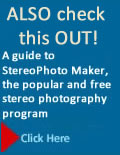Although true stereo effects are created by other techniques, you can simulate the illusion by alternately displaying the two images in a stereo pair as an animated GIF or Flash file and sometimes as an animated PNG (APNG) file or Java applet. Since both of your eyes are open as the images are displayed one after the other, the animation seems to wiggle—hence the name
wiggle 3D or
wobble 3D. The advantages of this approach are that wiggle stereos require no viewing glasses (so they are autostereoscopic images), can be displayed on any screen, and people with limited vision in one eye can also see the effect—try it yourself while viewing an animation with one eye closed. When you place one of these files on a Web page, it plays automatically when a visitor displays that page in their browser. The viewer doesn’t have to click it to play it. You can even drag an animated GIF file into a browser window and drop it. When you do so it starts playing immediately.
These animations can be set so they end when finished, or loop over and over. If one is set to play once, you have to click the browser's Refresh button to replay it. If set to loop, it plays over and over again so the effect is much more obvious.
The animated GIF format is the most popular format, perhaps because it's so simple to create, because it runs on any system without the need for additional software or hardware or because its been around far longer. Its only real problem is that it supports only 256 colors—compared to the millions of colors your camera captures. For higher quality, some programs let you create and then output these animations in a movie format such as AVI, MOV, MPEG, or Flash.
If you use only the original two images in a stereo pair for these 3D animations, the wiggle is jerky. To smooth the transition you can add intermediate images, creating what's called a multiview 3D JPEG. The Start3D.com Web site automates this process for you, creating multiview 3D images they call Piku-Piku (Japanese for "twitching"). When you upload a stereo pair, the site uses the left and right image as key frames and generates a series of frames between them. The result is a flash movie or animation that moves from frame to frame shifting the point of view and giving a smooth 3D effect similar to what you'd see if you viewed the original scene while moving your head from side to side.

Multiview 3D images are created using a stereo pair and a
depth map (also known as a
disparity or
Z-image) that uses gray color gradations to indicate each pixel's distance from the viewer at the time the picture was taken. White indicates areas closest to the camera and as objects get father away they get darker. Depth maps are used not only to create intermediate images between a stereo pair, but can also convert a 2D image to 3D.

Here the original image is on the left and its depth map is on the right. In between are two frames generated from the original and depth map using Triaxis StereoTracer.
The ability to package a series of images together as an animated GIF file or other format such as a Flash movie is integrated into many photo-editing programs and there are also specialized stand-alone programs developed specifically for this purpose. Some of these programs are discussed in Chapter 4 and listed in the appendix.
The wiggle effect works best when the main subject is centered in the middleground, with ample foreground and background elements to create parallax for depth perception. Vertical subjects, centered in the image hardly move but gain depth as the foreground and background shift. The wiggling directs the viewer's eyes to the unmoving central subject.

